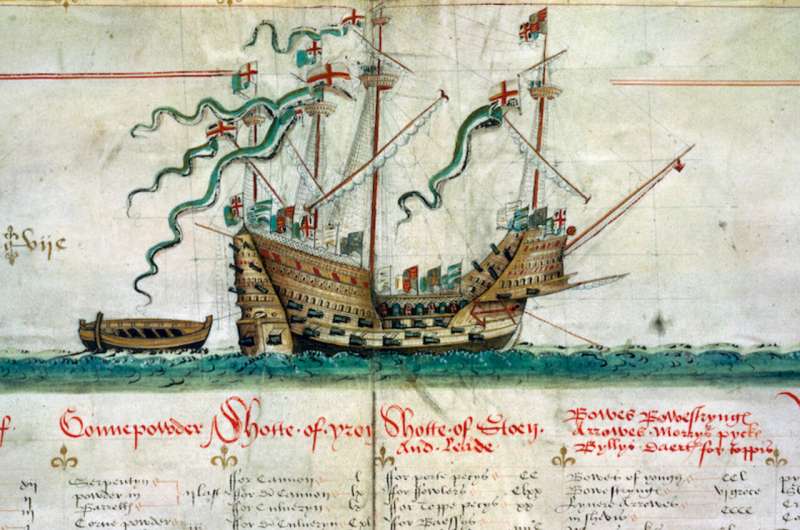The Mary Rose depicted on the Anthony Roll (1546), an illustrated inventory of King Henry VIII's navy (by permission of the Pepys Library, Magdalene College, Cambridge, UK). Credit: Royal Society Open Science (2021). DOI: 10.1098/rsos.202106
A team of researchers with Cardiff University, the Mary Rose Trust, HM Naval Base and the British Geological Survey's National Environmental Isotope Facility has found evidence of racial diversity among the crew of the Mary Rose—a warship from the time of King Henry the VIII. In their paper published in the journal Royal Society Open Science, they describe their study and analysis of the remains of eight sailors recovered from the wreck of the Mary Rose.
The Mary Rose served the Tudor navy for approximately 33 years, but was finally sunk during a battle in the Solent in 1545. The wreck was discovered back in 1971 and raised in 1982. Since that time, a dedicated museum houses not only the ship but the thousands of artifacts that were brought up along with it.
In this new effort, the researchers sought to learn more about the backgrounds of the crew. To that end, they selected the remains of eight of sailors chosen by their degree of preservation and their likely stations aboard the ship. In addition to using a technique called multi-isotope analysis to study the teeth, the researchers also noted artifacts found near the remains. Prior research had already shown that many of the artifacts found in the wreckage had not been made in England. In their work, the researchers found evidence showing that three of the eight sailors were not British—instead, two appeared to be from southern Europe and a third from North Africa.
The researchers noted that chemical tracers from the food and water the sailors had consumed as children were still in their teeth, which helped to place their geographical upbringing. Based on the evidence, the researchers assigned the sailors to their likely positions aboard the Mary Rose—among them were an officer, an archer, a royal archer, a carpenter, a gentleman, a cook and a purser. The researchers suggested an individual that appeared to have come from North Africa likely came from a southern part of Tunisia, the Atlas Mountains or Morocco. They suggest that the Tudor navy was much more racially diverse than has previously been thought.
More information: Jessica Scorrer et al. Diversity aboard a Tudor warship: investigating the origins of the Mary Rose crew using multi-isotope analysis, Royal Society Open Science (2021). DOI: 10.1098/rsos.202106
Journal information: Royal Society Open Science
© 2021 Science X Network























